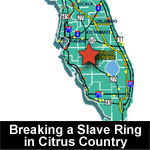 Drive
south from Orlando for about 100 miles along Rt.
27 and you'll come to the city of Lake Placid, positioned
squarely between Sarasota on the Gulf of Mexico
and Port Saint Lucie on the Atlantic. The steady
Florida sunshine and the gentle breezes flowing
from its 27 fresh water lakes makes Lake Placid
ideal for growing citrus. Indeed, the region supplies
much of the nation's crop of oranges and grapefruits.
Drive
south from Orlando for about 100 miles along Rt.
27 and you'll come to the city of Lake Placid, positioned
squarely between Sarasota on the Gulf of Mexico
and Port Saint Lucie on the Atlantic. The steady
Florida sunshine and the gentle breezes flowing
from its 27 fresh water lakes makes Lake Placid
ideal for growing citrus. Indeed, the region supplies
much of the nation's crop of oranges and grapefruits.
To
pick all this fruit every season, it takes a lot
of hands. The Ramos Brothers –
Ramiro and Juan – were among those who helped
furnish a stream of workers to local fruit growers.
In the process, they made millions. The Ramos
family owned three fruit harvesting businesses,
a grocery, two clothing stores, and over 30 pieces
of real estate.
One
problem, though, and the reason for this story:
their workers weren't workers in the traditional
sense. They were more like slaves. And the Ramos
brothers employed as many as 700 of them. They
forced these individuals to pick fruit for ten
hours a day, six days a week, with no time off.
They threatened them at gunpoint, promising torture
and death if they tried to escape. And they made
them live in filthy, substandard, and overcrowded
apartments.
How
did they recruit these workers? From
across the border. In this case, Mexican workers
slipped into Arizona illegally with the help of
a smuggler or "coyote." The Ramos brothers
would ask the coyote to ship them illegal aliens.
When the workers arrived, the brothers would charge
them $1,000 for their transportation to Florida.
Each week, the Ramos' would take most of the workers'
meager paychecks to "repay" the debt
and to cover the cost of food and rent. In reality,
though, no one was ever set free.
How was the ring broken? The
Ramos brothers got caught attacking (and knocking
unconscious) the owner of a van service that transported
migrant workers out of the area. Then, in April
2001, four Ramos workers escaped with the help
of the Coalition for Immokalee Workers. In 2002,
the Ramos brothers were tried and convicted. Earlier
this month, Ramiro Ramos was re-sentenced to 15
years in prison. His brother Juan, originally
sentenced to 12 years, will be re-sentenced in
May. Both were also ordered to forfeit $3 million
earned from their crimes.
Cooperation
Makes the Case: Once again, partnerships
were key. Special thanks to the U.S. Border Patrol
and the Highland County Sheriff's Office. And
thanks to all those who offered assistance to
the victims, including the Mexican Consulate in
Miami and the U.S. Department of Health and Human
Services.
Related
links: Press
Release | The
FBI's Civil Rights website | More
photos
Florida map courtesy of the Florida Department
of Transportation.
|
